When lacquered objects made in East Asia first reached Europe in about the early 16th century, they were highly prized for their flawless finish and light-reflecting qualities.
Lacquer became available to European elites, along with other luxury items including silk and porcelain, once Portuguese explorers discovered a sea route to the East around the southern tip of Africa and across the Indian Ocean. The flow of goods increased in the early 17th century when the Dutch and English East India Companies began to bring goods to markets in Amsterdam and London. By 1700 many European country houses and palaces contained examples of East Asian export lacquer.
Asian lacquer was admired as a precious and mysterious material. Adding to its rarity and desirability was the fact that the key ingredient, a resin extracted from the lacquer tree (toxicodendron vernicifluum) native to East Asia, did not survive the long duration of the sea voyage without hardening beyond use. European demand for lacquer was such that the Chinese and Japanese soon began to capitalise on this lucrative market by making lacquered objects specifically for export, in forms and styles to suit Western tastes. This trade was not restricted to China and Japan. Varieties of the lacquer tree also grew in other Asian countries including Vietnam, where the English had a trading post, although it has, so far, been impossible to distinguish export lacquerware made in Vietnam in the 17th century.
The earliest Japanese export lacquer, made from the 1570s to 1630 for Portuguese markets, was made in Western forms such as cabinets and bowls, with decoration very different from lacquer made for use in Japan. These first exports are today described as nanban, a Japanese term literally meaning 'Southern barbarian': foreigners whose ships arrived from the south. The decoration, in gold on a black background, sometimes inlaid with mother-of-pearl, covered almost the entire surface and was often contained within wide geometric borders. Later, from the 1630s, to suit the tastes of the Dutch and other northern European countries, Japanese lacquer makers adopted a more pictorial style in gold on a black background for their export ware.
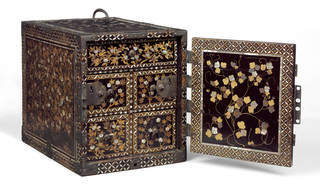
The Dutch East India Company, or VOC (Verenigde Oostindische Compagnie), established in 1602, became the largest trade and shipping company in the world at that time. In competition with the Portuguese, it established its own direct trade with Asia, importing a vast range of goods including spices, silk, porcelain and later, tea, as well as lacquer, which were then distributed across Europe through the Amsterdam market. During the 17th century, the Dutch dominated the Japanese trade. All over Europe, Japanese lacquer was regarded as superior in quality to all others. Europeans particularly prized Japanese lacquer in the form of cabinets with internal drawers, which were made especially for export. In European rooms they were often placed on table-height stands and positioned against a wall.
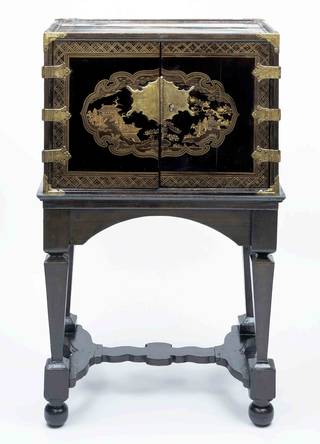
The English East India Company, established in 1600, also competed in the lucrative trade with Asia, establishing warehouses alongside their Dutch counterparts in Eastern ports. From the 1670s they traded directly with Chinese ports, with a trading post in Taiwan in 1672 and later in Amoy, Chusan and Canton. They imported a range of Chinese lacquered goods including tall folding screens and lacquered boards for use as wall panelling, or for applying as veneers to English-made furniture. Like the Japanese makers, the Chinese were quick to adapt to the demands of the European market.
During the 17th century the predominant Chinese export lacquer product was the folding screen (a traditional Chinese and Japanese form), made in a distinctive incised technique. The decoration was made by cutting designs into a lacquer surface laid over a thin coating of mixed brick dust, pig's blood and lacquer, then filling the hollows with pigments. Known in China as kuan cai ('engraved polychrome'), this colourful technique was generally described in Britain as 'Bantam work' and later as 'Coromandel' lacquer, from the names of the ports through which it was shipped to Europe.
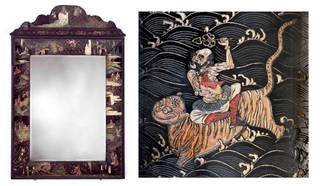
To cater for the growing European taste for lacquer, and to compete with increasing numbers of imported lacquer goods, European craftsmen attempted to imitate Asian lacquer, devising complex recipes using the ingredients available to them, such as sandarac (the resin of the North Africa Thuya tree), or shellac (a resin derived from the secretions of an insect living on trees in India). The quality of European imitation lacquer varied widely – some is so excellent in both design and materials that today it can be difficult to tell it apart from true East Asian lacquer without detailed examination.
In European countries, techniques imitating Asian lacquer were known by a variety of names, including 'Vernis Martin' in France and simply 'lacquer', or 'European lacquer' elsewhere. As Japanese lacquer was regarded as the finest, in Britain the term 'japan' became associated with lacquer in the same way that 'china' was used for porcelain, and the word 'japanned' is still used to describe imitation lacquer. In this article we are using the term 'japanned' for all European imitations of Asian lacquer, to make the distinction from true Asian lacquer.
Inspired by imported examples, the predominant form of European japanned furniture was initially the cabinet on stand, which became a desirable feature of Asian-inspired interiors along with collections of blue and white porcelain. From about 1700 japanned bureau-cabinets became popular in Britain, often in bright red with painted decoration in gold and colours. British japanned bureau-cabinets and suites of chairs were exported to Europe, especially Spain, Portugal, Italy and Germany.
When applying surface decoration, japanners based their designs either on examples of imported East Asian lacquer, or on printed designs like those in the widely-circulated book A Treatise of Japaning and Varnishing, by John Stalker and George Parker, published in 1688. Sometimes the decoration is a clear indicator that a piece was made in Europe, if Western motifs are included, or if the scale of the motifs is inconsistent, such as large flowers or birds combined with tiny human figures.

From the 1670s, increasing numbers of lacquered objects were imported from Asia. The merchants of the English East India Company made careful efforts to ensure that Chinese lacquered furniture met the demands of the home market. From as early as the 1670s, English artisans were sent to China to ensure that furniture forms were made according to Western taste. Sometimes undecorated furniture was sent out to be lacquered in China. Chinese merchants and artisans became increasingly familiar with Western tastes and by about 1730 were able to supply furniture such as bureau-cabinets and folding tables in complex Western forms. In the 18th century, many pieces made in China for export to Europe were decorated in black and gold lacquer, imitating the more expensive and rarer Japanese lacquer, although this was not a typically Chinese technique.
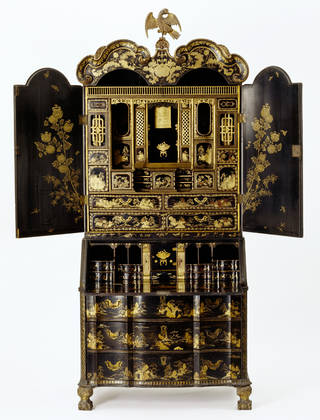
By the mid-18th century, European-made japanning was becoming increasingly sophisticated. Chinese and Japanese motifs remained popular, but designs began to reflect the Western tradition. Japanning industries developed in several European centres, each with a distinctive style. In the town of Spa, in south-East Belgium, an early centre for japanning, small items such as boxes and dressing cases were made to sell to visitors arriving to 'take the waters'.
The most prominent of the Spa japanners were the Dagly family, one of whom, Gérard Dagly (1660 – 1715), was summoned to the Berlin court, where he established a workshop making japanned objects in close imitation of Japanese lacquer. His brother Jacques Dagly (1665 – 1728) moved to Dresden, the capital of Saxony, which also became a significant centre for japanning. Dresden was established as a major cultural centre by Augustus II ('the Strong') Elector of Saxony, (1670 – 1733), who made a large collection of East Asian lacquer and porcelain and wanted to expand it with locally-made japanning. The Dresden workshop produced extremely high-quality products in a variety of colours including blue and white, colours not possible in East Asia owing to the constraints of the native lacquer used.
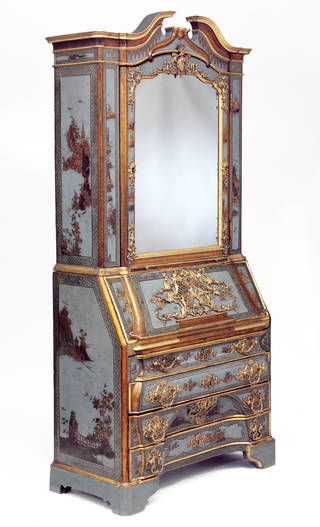
In Paris, a comparable japanning workshop was established early in the 18th century. A distinctive technique was developed in which lustrous coloured varnishes in bright colours ranging from black to red, green and deep blue, were applied to furniture and personal items such as snuff-boxes and fans. Vernis Martin (Martin varnish), named after its greatest practitioners, brothers Guillaume (1689 – 1749) and Etienne-Simon Martin (1703 – 1770), has become a generic term referring to high-quality imitation lacquer produced in 18th century France. Since they did not mark their pieces, most French makers remain anonymous, and the Martins' own production can be distinguished only by the high quality of the japanning and painting.

As the taste for oriental decoration grew in France in the middle years of the 18th century, the demand for lacquer was so great that dealers in luxury goods (marchands-merciers) dismantled Japanese cabinets and Chinese Coromandel screens imported in earlier years, in order to re-use the lacquer panels on new French furniture. The same had been done on a smaller scale in England since before 1700, but the technique was perfected by expert Parisian craftsmen who were able to cut and bend the lacquer, and to balance the decoration on the finished piece with japanned additions. Mounts of gilded brass were often applied to disguise the joins and to provide a rich contrast with the black lacquer. The demand for East Asian lacquer for use as veneer was so great that very few Japanese cabinets survive intact in French collections.
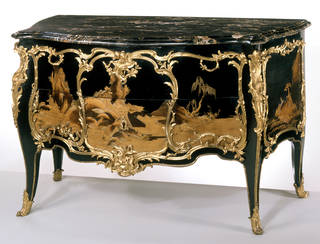
In both France and England, decoration inspired by art and design from China and other Asian countries, known as Chinoiserie, from Chinois, the French for Chinese, became a highly fashionable style, at its height in the years 1750 to 1765. Mirrors, beds and chests of drawers were japanned or painted with Chinese ornament.
After about 1765 the fashion for lacquer and japanning on furniture was waning, but varnishing techniques were successfully applied to a new type of metalware. This was commercially produced japanned tinplate (sheet-iron coated with tin). A successful method for applying a lacquer-like varnish to tinplate was developed at an ironworks at Pontypool in Wales, and was soon taken up by manufacturers in Birmingham and nearby towns, who produced large numbers of japanned trays, tea caddies and other small items. The technique involved slowly drying the varnish in kilns.
The same method, though at lower temperatures, was also successfully applied to papier-mâché, which was made of either paper pulp or numerous sheets of paper pasted together, and to wood. Papier-mâché was a light and strong material suitable for small items such as trays, but when made into furniture it was sometimes reinforced with internal metal supports, and the legs of papier-mâché chairs were made of solid wood. The great advantages of papier-mâché were that it could be moulded into curvaceous shapes – so popular in the Victorian period, and that it had a smooth surface that did not crack, suitable for applying light-reflective japanning. Papier-mâché items were often japanned black, with inset pieces of mother of pearl, and decorated with colours and varnished silver foil imitating gold. The colour palette derived from Eastern Asian lacquer, but the decorative motifs were usually entirely Western. Japanned papier-mâché became a hugely successful industry in the Birmingham area and production continued into the first two or three decades of the 20th century.
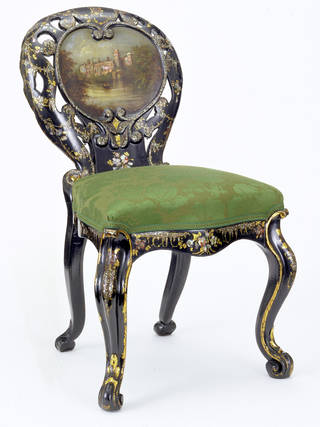
East Asian lacquer continued to influence European art throughout the later 19th and the 20th centuries, with periodic revivals of interest. Since the mid-17th century Japan had tightly controlled trade with the West, but reopened its ports in 1853, after which Japanese products including fans, silks and lacquered boxes poured into Europe. Exhibited in museums and sold in shops such as Liberty's in London (established in 1875), Japanese goods became highly fashionable and influenced European decorating styles in the period 1851 to 1900.
From the early 16th century, true Asian lacquer had been unavailable in Europe, so European craftsmen had done their best to imitate the effects of Asian lacquer using other natural ingredients. By the early 1900s ways were devised to successfully transport Asian lacquer to Europe for application there. Japanese craftsmen with the knowledge of how to use it had also arrived in Europe. The Irish architect and designer Eileen Gray (1878 – 1976) studied the art of Japanese lacquer working in Paris with Seizo Sugarawa (1884 – 1937), a Japanese artisan who had come to Paris to repair lacquer work exhibited in the Exposition Universelle of 1900. Gray became one of the first Westerners to work with true East Asian lacquer, which she applied to her own contemporary furniture designs.



